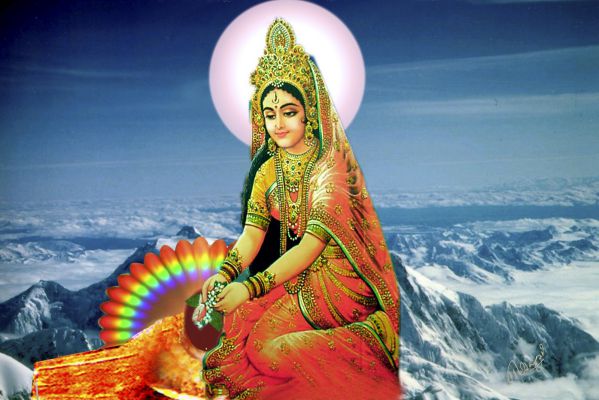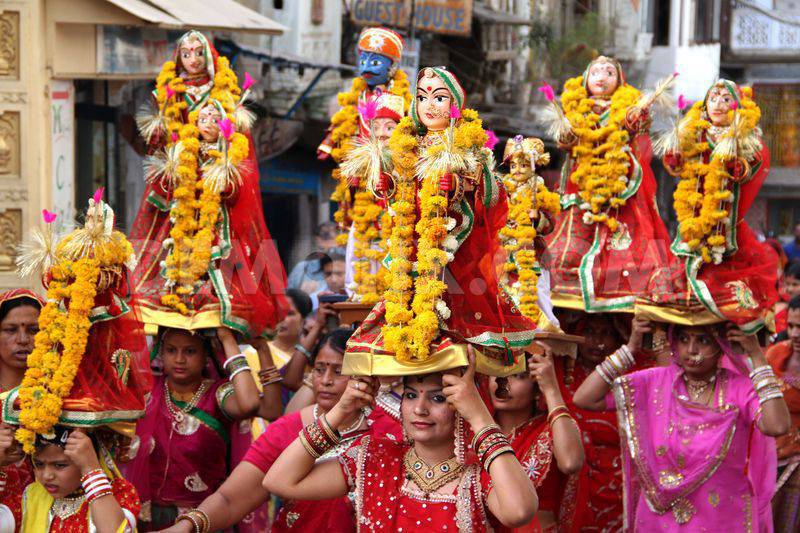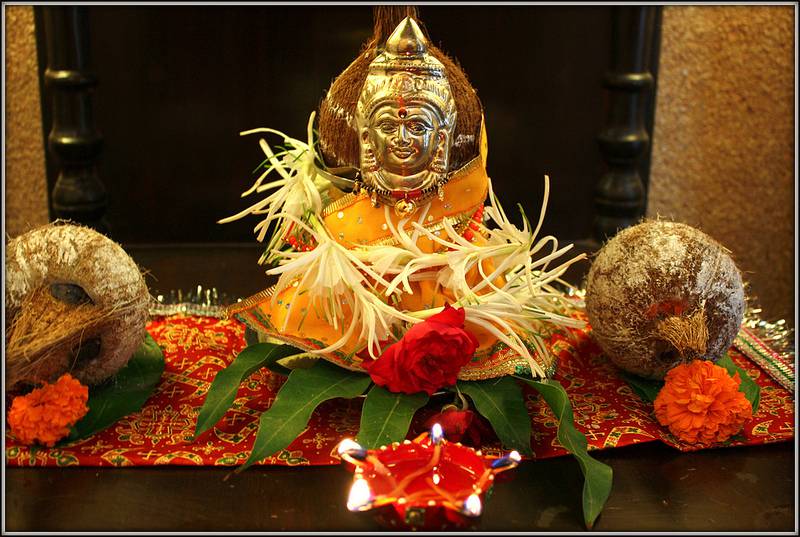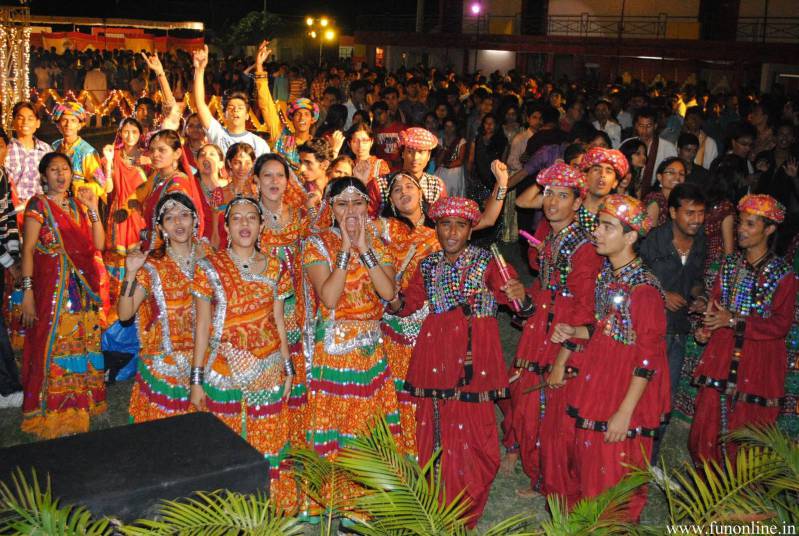No products in the cart.
Goddess Parvati – Hindu Goddesses and Deities
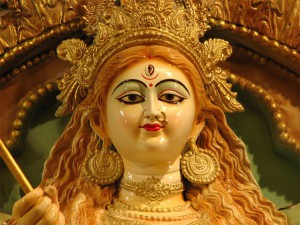 Parvati is the gentle and nurturing aspect of Hindu goddess Shakti. She is the Hindu goddess of love, fertility and devotion. Also, She is the mother goddess in Hinduism and source of power and beauty. She is the perfect incarnation of Adi Para Sakthi. She has many attributes and aspects, each of her aspects is expressed with a different name, giving her over 108 names in regional Hindu mythologies of India. Along with Lakshmi (goddess of wealth and prosperity) and Saraswati (goddess of knowledge and learning), she forms the trinity of Hindu goddesses same as god trinity of Shiva Vishnu and Brahma.
Parvati is the gentle and nurturing aspect of Hindu goddess Shakti. She is the Hindu goddess of love, fertility and devotion. Also, She is the mother goddess in Hinduism and source of power and beauty. She is the perfect incarnation of Adi Para Sakthi. She has many attributes and aspects, each of her aspects is expressed with a different name, giving her over 108 names in regional Hindu mythologies of India. Along with Lakshmi (goddess of wealth and prosperity) and Saraswati (goddess of knowledge and learning), she forms the trinity of Hindu goddesses same as god trinity of Shiva Vishnu and Brahma.
Parvata is one of the Sanskrit words for “mountain”; “Parvati” derives her name from being the daughter of king Himavan (also called Himavat, Parvat) and mother Mena. King Parvat is considered lord of the mountains and the personification of the Himalayas; Parvati implies “she of the mountain”.
FAMILY:
Parvati is the divine consort of the Hindu deity Lord Shiva who is known as the destroyer, recycler and regenerator of universe and all life. She is the daughter of mountain king Parvat and mother Mena. She is the second consort of Lord Shiva after the death of his first wife Sati. She is not just a loving wife but also a devoted mother to Lord Kartikeya and Lord Ganesha. Her elder sister is goddess Ganges. Some communities also believe her to be the adopted sister of Vishnu.
ICONOGRAPHY:
Parvati, the gentle aspect of Devi Shakti, is usually represented as fair, beautiful and benevolent. She typically wears a red dress (often a sari), and may have a head-band. When depicted alongside Shiva, she generally appears with two arms, but when alone, she may be depicted having four. These hands may hold conch, crown, mirror, rosary, bell, dish, farming tool such as goad, sugarcane stalk, or flowers such as lotus. One of her arms in front may be in the Abhaya mudra (hand gesture for ‘fear not’), one of her children, typically Ganesha, is on her knee, while her elder son Skanda may be playing near her in her watch. In ancient temples, Parvati’s sculpture is often depicted near a calf or cow – a source of food. Bronze has been the chief metal for her sculpture, while stone is next most common material.
A common symbolism for her and her husband Shiva is in the form of yoni and linga respectively. In ancient literature, yoni means womb and place of gestation, the yoni-linga metaphor represents “origin, source or regenerative power”. The linga-yoni icon is widespread, found in Shaivite Hindu temples of South Asia and Southeast Asia. Often called Shivalinga, it almost always has both linga and the yoni. The icon represents the interdependence and union of feminine and masculine energies in recreation and regeneration of all life. In some temples and arts, the iconographic representation of sexuality, fertility and energies of Parvati and Shiva, is more explicit, where they are shown in various stages of their sexual form and union.
In some iconography Parvati’s hands may symbolically express many mudras (symbolic hand gestures). For example, Kataka — representing fascination and enchantment, Hirana — representing the antelope, the symbolism for nature and the elusive, Tarjani by the left hand — representing gesture of menace, and Chandrakal — representing the moon, a symbol of intelligence. Kataka is expressed by hands closer to the devotee, Tarjani mudra with the left hand but far from devotee.
If Parvati is depicted with two hands, Kataka mudra — also called Katyavalambita or Katisamsthita hasta — is common, as well as Abhaya (fearlessness, fear not) and Varada (beneficence) are representational in Parvati’s iconography. Parvati’s right hand in Abhaya mudra symbolizes “do not fear anyone or anything”, while her Varada mudra symbolizes “wish fulfilling”. In Indian dance, Parvatimudra is dedicated to her, symbolizing divine mother. It is a joint hand gesture, and is one of sixteen Deva Hastas, denoting most important deities described in Abhinaya Darpana. The hands mimic motherly gesture, and when included in a dance, the dancer symbolically expresses Parvati. Alternatively, if both hands of the dancer are in Ardhachandra mudra, it symbolizes an alternate aspect of Parvati.
Parvati is sometimes shown with golden or yellow colour skin, particularly as goddess Gauri, symbolizing her as the goddess of ripened harvests.
In some manifestations, particularly as angry, ferocious aspects of Shakti such as Durga or Kali, she has eight or ten arms, and is astride on a tiger or lion. In benevolent manifestation such as Kamakshi or Meenakshi, a parrot sits near her right shoulder symbolizing cheerful love talk, seeds and fertility. Parrot is found with Parvati’s form as Kamakshi – the goddess of love, as well as Kama – the cupid god of desire who shoots arrows to trigger infatuation. A crescent moon is sometimes included near the head of Parvati particularly the Kamakshi icons, for her being half of Shiva. In South Indian legends, her association with parrot began when she won a bet with her husband and asked for his loin cloth as victory payment; Shiva keeps his word but first transforms her into a parrot. She flies off and takes refuge in the mountain ranges of south India, appearing as Meenakshi (also spelled Minakshi).
FESTIVALS AND VRATS:
Festivals associated with Goddesses Parvati are:
- The Gowri Habba, or Gauri Festival, is celebrated on the seventh, eighth, ninth of Bhadrapada (Shukla paksha). Parvati is worshipped as the goddess of harvest and protectress of women. Her festival, chiefly observed by women, is closely associated with the festival of her son Ganesha (Ganesh Chaturthi). The festival is popular in Maharashtra and Karnataka.
- In Rajasthan, Gauri is worshipped during the Gangaur festival, which commences on the first day of Chaitra, just the day following Holi. This festival continues for a period of 18 days. Images of Issar and Gauri are made from clay and worshipped during the festival.
- Another popular festival in reverence of Parvati is Navratri, in which all her manifestations are worshiped over nine days. Popular in eastern India, particularly in Bengal, Odisha, Jharkhand and Assam, as well as several other parts of India such as Gujarat, this is associated with Durga, with her nine forms i.e. Shailputri, Brahmacharini, Chandraghanta, Kushmanda, Skandmata, Katyani, Kalratri, Mahagauri, Siddhidaatri.
- The Gauri tritiya is celebrated from Chaitra shukla third to Vaishakha shukla third. It is said that Parvati spends a month at her parent’s home at this time. This festival is popular in Maharashtra, less observed in North India and is virtually unheard of in Bengal. This is a festival mostly conducted by married women and is somewhat similar to the Indian haldi-kumkum ceremony, where girls and women are invited to households and gifted flowers and fruits, coconuts, small gifts and packets of turmeric and saffron. The unwidowed women of the household erect a series of platforms in a pyramidal shape with the image of the goddess at the top and collection of ornaments, images of other Hindu deities, pictures, shells etc. below. At night, prayers are held by singing and dancing.
- Teej is a significant festival for Hindu women, particularly in northern and western states of India. Parvati is the primary deity of the festival, and it ritually celebrates married life and family ties. It also celebrates the monsoon. The festival is marked with swings hung from trees, girls playing on these swings typically in green dress (seasonal color of crop planting season), while singing regional songs. Historically, unmarried maidens prayed to Parvati for a good mate, while married women prayed for the well being of their husbands and visited their relatives. In Nepal, Teej is a three-day festival marked with visits to Shiva-Parvati temples and offerings to linga. Teej is celebrated as Teeyan in Punjab.
MANTRA:
Swayamvara parvathi Moola Manthra:
|| Om Hreem Yogini Yogini Yogeswari Yoga Bhayankari Sakala Sthavara
Jangamasya Mukha Hrudayam Mama Vasam Akarsha Akarshaya Namaha ||
INCARNATIONS AND SWAROOP:
Goddesses Parvati is the source of all forms of goddesses. She is worshiped as one with many forms and name. Her different mood brings different forms or incarnation. There are ten aspects of Goddess Parvati and these are known to be a representation of her power and knowledge. All these ten aspects are jointly known as Dasamahavidyas and each one of them is a form that she undertook to destroy evil and bless her worshippers.
- Kali is the first representation of Goddess Parvati and she was known as the destroyer (also known as the Goddess of time)
- Tara is known as the source from which the universe evolves as she is known to represent the power of the golden embryo (also represent Boundless space or void
- Sodasi is the third representation of Goddess Parvati and is known to represent perfection and fullness. The literal meaning of the term “Sodasi” is one who is sixteen years of age.
- The forces of the material world are represented by Vidya Bhuvanevari
- Desires and temptations that often lead to destruction and death are represented by the fifth form of Goddess Parvati known as Bhairavi.
- Vidya Chinnamasta is the sixth form of Goddess Parvati and is known to represent the created world in a continuous cycle of creation and destruction. She is often shown as holding her own severed head and drinking blood from it.
- Destroying the world by fire is the seventh form of Goddess Parvati and is known as Dhumavati. After the world is destroyed by fire only the smoke and ashes will remain
- Vidya Bagala is the eight form of the Goddess and is known to represent cruelty, hatred and jealousy. These are the negative aspects of any individual.
- The ninth form of Goddess Parvati is Matangi, the power of domination.
- Vidya Kamala (Goddess Lakshmi) is said to be the Goddess of fortune.
All the ten forms of Goddess Parvati are known to represent the loving and aggressive nature of the Goddess. She is also known as the Goddess of power.
TEMPLES:
There are many famous temples for Goddess Parvati in India and each one of them has a legendary story associated with it. Each of these temples were constructed and dedicated to the Goddess as a mark of reverence. Depending on where the temple is situated the architecture and sculptures that are installed will differ.
Here is a list of some of famous temples that are dedicated to Goddess Parvati:
ॐ The Parvati temple in Khajuraho, Madya Pradesh ॐ
ॐ Garjia Devi Temple, Uttarakhand ॐ
ॐ Sri Garbharakshambikai temple, Thirukarugavur, Thanjavur ॐ
ॐ Ambaji temple at Ambaji, Gujarat ॐ
ॐ Tiruvairanikulam Sri Parvati temple, Aluva ॐ
ॐ Meenakshi temple at Madurai ॐ
ॐ Visalakshi temple at Banaras, Uttar Pradesh ॐ
ॐ Kamakshi Amman temple at Kanchipuram ॐ
ॐ Akilandeswari temple at Thiruvanaikaval ॐ
ॐ Attukal Temple situated in Thiruvananthapuram, Kerala ॐ
Millions of devotees from all over India and abroad visit these famous temples dedicated to Goddess Parvati each year and seek her blessing.


